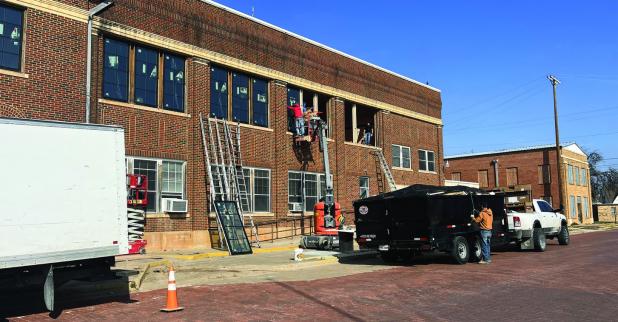
OEDC tackles Main St, courthouse, housing
The Olney Economic Development Corporation (OEDC) board of directors met on Feb. 12 to discuss several ongoing projects crucial to the city’s growth, including the rehabilitation of the Old City Hall, the push for new housing developments, and efforts to secure federal and state infrastructure funding.
Revitalizing the Old City Hall
The OEDC board heard an update from OEDC executive director Tom Parker on the status of the ongoing rehabilitation of the century- old Sub-Courthouse, on South Grand Avenue, also known locally as the Old City Hall. Workers last week completed the installation of 52 new windows, a new central heating and cooling system, and probably would have new flooring at the building’s two entrances completed within a week, Mr. Parker said.
The OEDC plans to spend approximately $400,000 to rehabilitate the historic building to better utilize more of the office space and to eventually re-open its large ballroom and gymnasium for community activities. The second floor has been unused for decades due to water damage from a leaking roof, as well as neglect.
The project has proceeded on schedule and on budget, despite unforeseen structural issues, such as outdated electrical wiring and necessary stucco and wood trim repairs, he said. The board approved invoices for work done so far, but deferred deciding whether to repaint the entire lower floor, which houses several county offices, until a later date.
“We’re still well within our budget, but things are ratcheting up,” Mr. Parker said. He said painting the interior and replacing flooring on the first floor would be the next major tasks, with estimates expected in the coming weeks. The goal is to ensure the building meets modern safety and efficiency standards while preserving its historical integrity, he said.
Addressing Housing Needs A key focus of the meeting was the ongoing effort to bring more housing to Olney to accommodate the city’s workforce – a job made challenging by a lack of infrastructure to support expansion outside the central city.
Olney City Administrator Simon Dwyer briefed the board on grants that the City is pursuing to support expansion of the water and sewer lines. Board members discussed various initiatives to encourage residential development, including potential partnerships with private landowners and developers.
A recent assessment identified two key areas for future housing expansion— one north of Highland Avenue near The Refuge Christian Community Center and another near the Olney Country Club. The sizes of the two vacant parcels of land suggest these areas could accommodate between 60 and 85 new homes, addressing a pressing need for more affordable and workforce housing, Mr. Dwyer said.
The board discussed the economic benefits of higher-density housing projects, with Mr. Parker noting that reducing lot sizes could lower infrastructure costs and make the projects eligible for more federal or state dollars to develop the necessary sewer and water lines and roads. The discussion also touched on zoning and annexation strategies to ensure that new developments align with the city’s long-term growth plan.
Infrastructure and Grant Opportunities Mr. Parker disclosed ongoing conversations with the Texas Capital Fund and the Community Development Block Grant (CDBG) program as potential funding sources for new and upgraded infrastructure.
“There’s a lot of opportunity for grants, but the process is complex,” he said. “We need to determine whether to work with the city or county on applications or hire a specialized grant writer to maximize our chances.”
The board also discussed transportation improvements in Olney’s downtown district. A Safe Streets initiative aims to slow traffic and enhance pedestrian safety. Proposed measures include adding plastic traffic flags, adjusting traffic flow patterns, and installing a pedestrian crossing signal at Grand Avenue.
Another infrastructure challenge under review is securing additional water sources for the city. Mr. Parker asked for, and received board approval to issue a request for proposals (RFP) for alternative water supply projects.
Those plans could include capturing waters that flood Olney’s Main Street and the airport during heavy downpours, and a new water tower near the Country Club to improve water pressure, he said.
“We need to take formal action on this so that we can make real progress,” said Parker.
“Without water, future development is impossible.”
